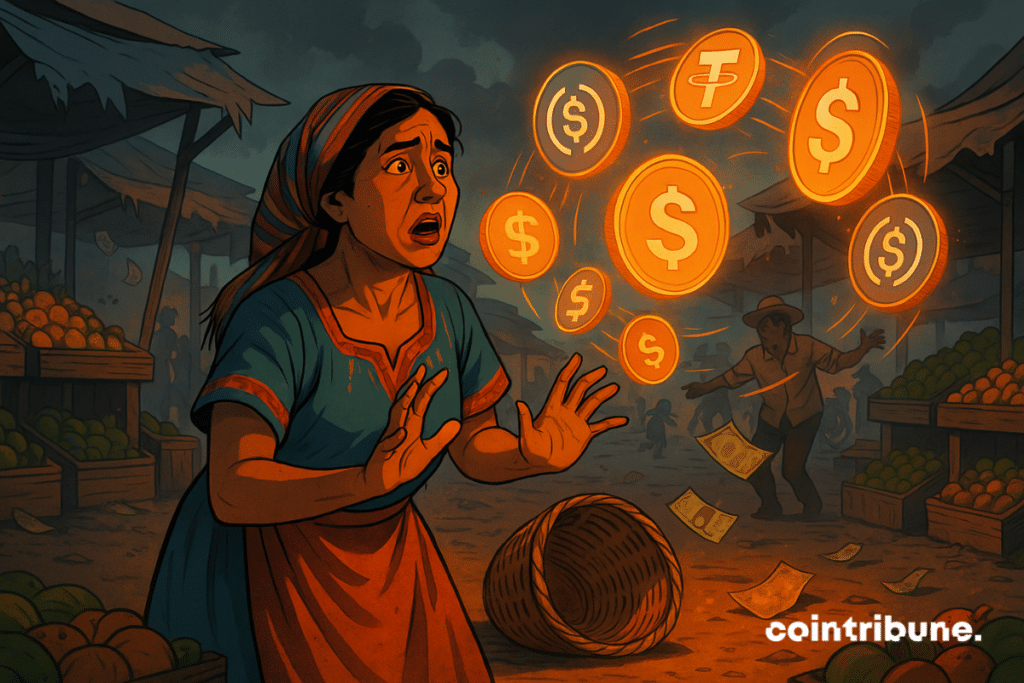Moody’s Flags Danger As Stablecoins Spread Globally
What if stablecoins, supposed to embody stability, became a threat to the global financial balance? In a recent report, Moody’s Ratings warns against their growing adoption, particularly in emerging countries. These assets, now used far beyond traditional crypto circles, could weaken central banks’ control, erode bank deposits, and cause systemic shocks.

In brief
- Moody’s warns about the risks of “crypto-ization” caused by the growing use of stablecoins in emerging economies.
- The agency believes these assets could weaken central banks’ control over monetary policy.
- The flight of bank deposits towards stablecoins poses a direct threat to the stability of local financial systems.
- This regulatory asymmetry could increase global economic imbalances and strengthen the dependence of unregulated countries.
Increasing pressure on monetary sovereignty
In a report published on September 25, Moody’s Ratings worries about the growing impact of stablecoins on emerging economies, while the Bank of Canada calls for their rapid regulation.
The rating agency emphasizes that the fast spread of these assets, often backed by the US dollar, could harm central banks’ ability to steer their economic policies.
“The widespread use of stablecoins could weaken central banks’ control over interest rates and exchange rate stability”, warns Moody’s. This dynamic, which the agency calls “crypto-ization”, is especially concerning in regions where the local currency is already under pressure and financial institutions lack solidity.
Moody’s identifies several possible consequences of massive stablecoin adoption in lightly regulated or structurally fragile economies :
- A loss of influence by central banks : local monetary authorities could lose their ability to effectively manage the money supply, especially if stablecoins gradually replace local currencies in daily transactions ;
- The erosion of traditional bank deposits : according to Moody’s, “banks could face deposit outflows if individuals move their savings into stablecoins or crypto wallets” ;
- An increase in systemic risk : in countries without adequate supervision, a loss of confidence in a stablecoin’s reserves could trigger massive withdrawals, or even require costly public bailouts if the token’s peg fails;
- An adoption driven by necessity, not speculation : in several countries in Africa, Latin America, and Southeast Asia, stablecoins are used as a solution to inflation, local currency volatility, or high international transfer fees.
The agency concludes that this transition, although sometimes seen as a lever for financial inclusion, could actually accentuate the fragility of already vulnerable economic systems by shifting monetary trust towards private or decentralized entities, often escaping any public oversight.
Fragmented regulations, amplified risks
Moody’s does not just make an economic observation. The agency also reveals the regulatory gaps that worsen the situation. Today, less than a third of countries worldwide have a complete regulatory framework governing these assets.
This lack of clear and harmonized standards exposes economies, especially the most vulnerable, to unforeseen shocks. “Despite their perception as safe assets, stablecoins introduce systemic vulnerabilities: insufficient supervision could trigger panics on reserves and force costly bailouts if pegs collapse”, the report points out.
Conversely, some economic powers are starting to regulate the sector. The European Union finalized, on December 30, 2024, the implementation of the MiCA regime, an ambitious regulation that imposes strict standards on reserves and transparency for stablecoin issuers.
In the United States, the GENIUS Act established a binding legal framework for the issuance and management of these assets. Even China, after banning crypto trading and mining in 2021, seems to be softening its stance. Beijing now considers yuan-backed stablecoins, while accelerating the development of its digital currency through an operational center opened in Shanghai.
This divergence in regulatory approach sketches a two-speed global landscape. On one side, structured jurisdictions that regulate the risks linked to stablecoins. On the other, grey zones where these assets develop without adequate supervision. Ultimately, this imbalance could heighten economic and geopolitical inequalities, giving regulated nations a structural advantage, while countries left on their own could become dependent on monetary infrastructures they no longer control.
Maximize your Cointribune experience with our "Read to Earn" program! For every article you read, earn points and access exclusive rewards. Sign up now and start earning benefits.
Diplômé de Sciences Po Toulouse et titulaire d'une certification consultant blockchain délivrée par Alyra, j'ai rejoint l'aventure Cointribune en 2019. Convaincu du potentiel de la blockchain pour transformer de nombreux secteurs de l'économie, j'ai pris l'engagement de sensibiliser et d'informer le grand public sur cet écosystème en constante évolution. Mon objectif est de permettre à chacun de mieux comprendre la blockchain et de saisir les opportunités qu'elle offre. Je m'efforce chaque jour de fournir une analyse objective de l'actualité, de décrypter les tendances du marché, de relayer les dernières innovations technologiques et de mettre en perspective les enjeux économiques et sociétaux de cette révolution en marche.
The views, thoughts, and opinions expressed in this article belong solely to the author, and should not be taken as investment advice. Do your own research before taking any investment decisions.